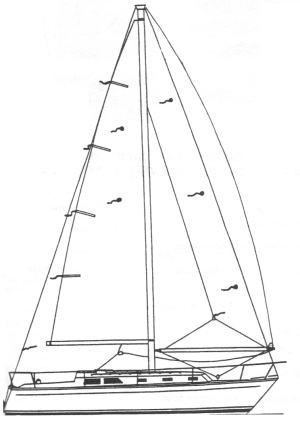A few words about a simple tool that can make sailing safer and more fun
Telltales, are simple devices made out of nylon, wool yarn, cassette tape, etc. and attached to a sail (jib or main) by adhesive locator discs or pulled through the sail with a proper needle and knotted to stay in place. This wonderful little tool is both low cost and very effective if you position it properly and understand how to read them. The following should help you to do both, The end result should make you and your boat better sailors and increase your level of fun!

Start with the headsail
Let’s look at the HEADSAIL first since it’s trimmed first. telltales should be positioned 8″ to 12″ back from the luff. I usually use my wrist to my elbow and by dividing the luff into three quarters you will put on three sets, port and starboard, one set each at the quarter, half, and three-quarter mark of the sail (refer to the diagram).
You might have to move the location up or down a bit to avoid a seam, which can cause the telltale to hang up. I prefer adhesive-backed locator discs made out of insignia sloth. These seem to work well, come in a variety of colors, and allow you to position the port and starboard telltales at different levels which will let you see both telltales, since during daylight hours the shadow of the one on the back side will usually show through. If you have acetate trim windows you will have a great view of both telltales.
When sailing close hauled or close reaching, trim the jib until it just stops luffing. Notice the telltale on the windward side. When it stops fluttering and lays smoothly against the sail you are in trim. Check the telltale on the leeward side, it should also be streaming aft, lying still and be parallel to the windward telltale.
At this point, check all telltales top to bottom, If they are all performing the same the headsail is sheeted in properly and you are “in the groove”. If the top one is fluttering move the sheeting block forward a bit. If the bottom telltale is fluttering move the block aft.
Once the sheeting angle is correct and the sail is trimmed properly, you can use the telltales to drive the boat. Since they are lighter than sail cloth they will tell you when there is a change in the wind and give you a chance to adjust the helm before luffing the sail.
Heading up should cause the windward telltale to break first, flying upward. When falling off the leeward ones will break and begin to flutter. The more you work with them the better you will become at reading the information they give you.
Now check the mainsail
Now lets look at the MAINSAIL. Over 50% of all the sails we clean and recondition at our plant and loft are mainsails, yet fewer than 20% have telltales in place. Telltales properly installed on the main can tell you a lot about the relationship between the headsail and main and the “slot” between them.
Telltales should be positioned on the leech at each batten; usually it takes 4. In the center of the main a little forward of center you will place a pair much in the same way you attached the ones one the jib. Put them between the first and second battens and between the second and third battens, again avoiding seams. (Refer to diagram).
While going to windward with both sails properly trimmed, keep your eye on the leeward telltales on the main. When you have them settled down, lying flat and streaming aft, look at the windward telltales.
At first you will find it difficult to have both sides streaming aft. First try flattening the main. If the bottom pair looks good but not the top, you are close. Ease the traveler and tighten the mainsheet. This should firm up the leech and give you the desired look. Don’t get discouraged, a little practice will do wonders.
Then look at the leech
Now let’s look at the leech. Exhaust or airflow as it leaves the main should have all telltales streaming aft. This will help to confirm your leech tension setting. Now move the traveler to windward. The telltales should start breaking at the top and work down. If it starts at the bottom first, add more leech tension. Make these adjustments as little at a time. It’s more an exercise in finesse than brute strength.
As you bear off and ease your sails out, use the leeward telltales on the jib and the leech telltales on the main to trim well past a beam reach. As you have trimmed in, so will you let out. A little practice will make it second nature, But don’t get easily satisfied or complacent! When all looks well I usually ease the sheets a bit and glance at the knot meter. Here we go again.
Don’t forget the rig
Now we’ve covered the sails – how about the rig? Although you don’t see it a lot, a lone telltale placed just above your head on the backstay can be a lot of help as you start down wind. Make sure its not in a position to foul or hand up. So goes the telltale, so goes the boom. Use the telltales position to square the boom and mainsail to the wind. If your telltale on the backstay is flying forward to port then the boom and mainsail should also be on the port side, square to the wind.
One last bit of info: If you like flying a spinnaker, you may find that trimming the pole and chute is much easier if you have a telltale attached to the bridle at the center of the pole. This helps to square the pole to the wind, then trim the chute.


